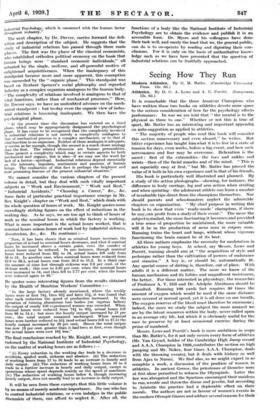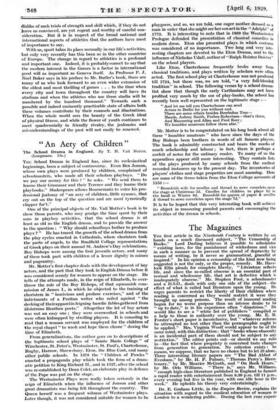Seeing How They Run
Modern Athletics. By G. M. Butler. (Cambridge University
Press. 12s. 6d.)
Athletics. By D. G. A. Lowe and A. E. Porritt. (Longinansi
12s. 6d.)
IT is remarkable that the three Amateur Champions who have written these two books on athletics devote some space to the serious consideration of how far the psychology affects performance. In war we are told that " the mental is to the physical as three to one." Whether or not this is true of sport, Mr. Butler has an interesting and important appendix on auto-suggestion as applied to athletics.
" The majority of people who read this book will consider this section unnecessary and even absurd," he writes. But bitter experience has taught him what it is to live in a state of tension for days, even weeks, before a big event, and how such nervousness and fear may be overcome. Relaxation is the secret : first of the extremities—the toes and ankles and wrists—then of the facial muscles and of the mind. " This is not especially easy at first, " but Mr. Butler has proved the value of it both in his own experience and in that of his friends.
His book is particularly well illustrated and planned. By a study of the action photographs—showing, for instance, the difference in body carriage, leg and arm action when striding and when sprinting—the adolescent athlete can learn a number of invaluable tips direct from the champions themselves. Nor should parents and schoolmasters neglect the admirable chapters on organization. " My chief purpose in writing this book is to show that even ready-made ' champions, if there be any,can profit from a study of their event." The more the subject isstudied, the more fascinating it becomes; and provided a true sense of proportion be maintained, the more valuable will it be in the production of mess sana in compose nano. Running trains the heart and lungs, without whose vigorous functioning the brain cannot be at its best.
All three authors emphasize the necessity for moderation in athletics for young boys. At school, say Messrs. Lowe and Porritt, training should aim at " the acquisition of style and technique rather than the cultivation of powers of endurance and stamina." A boy is, or should be, automatically fit. Any special course of dieting is, therefore, out of place. With adults it is a different matter. The more we know of the human mechanism and its foibles and magnificent resistances, the better. For those interested in physiology, the researches of Professor A. V. Hill and Dr. Adolphe Abrahams should be consulted. Running 100 yards fast requires 80 times the amount of oxygen which would be used if the same distance were covered at normal speed, yet it is all done on one breath. The oxygen reserves of the blood must therefore be enormous indeed, the more we study the subject the more amazed we are by the latent resources within the body, never called upon in an average city life, but which it is obviously useful for the race to preserve by at least occasional exercise during the prime of manhood.
Messrs. Lowe and Porritt's book is more ambitious in scope than Mr. Butler's, for it not only covers every form of athletics (Mr. Van Geyzel, holder of the Cambridge High Jump record and A.A.A. Champion in 1926,contributes the section on high jumping and Mr. Nokes, four times A.A.A. Champion, deals with the throwing events), but it deals with history as well from Ajax to Nurmi. We find also, as we might expect in so complete a work, a discussion of the position of women in athletics. In ancient Greece, the priestesses of Demeter were at first alone permitted to witness the Olympiads. Later the law was abrogated and the Spartans encouraged their maidens to run, wrestle and throwthe discus and javelin, but according to Aristotle the practice had a deplorable effect on their morals. The authors are not in favour of women's events in the modern Olympic Games and adduce several reasons for their .dislike of such trials of strength and skill which, if they do not _leave us convinced, are yet cogent and worthy of careful con- sideration. But it is in respect of the broad national and international aspects of athletics that the authors have most of importance to say.
With us, sport takes its place normally in our life's activities, but only very recently has this been so in the other countries of Europe. The change in regard to athletics is a profound and important one. Indeed, it is probably correct to say that the modern interest in the Games is a factor in international good will as important as Geneva itself. As Professor P. J. Noel Baker says in his preface to Mr. Butler's book, there are many of us who look forward to an even wider extension of the oldest and most thrilling of games . . . to the time when .every city and town throughout the country will have its stadium and when the athletes who use these stadia will be numbered by the hundred thousand." Towards such a possible and indeed eminently practicable state of affairs both these volumes contribute by their counsels and illustrations. When the whole world sees the beauty of the Greek ideal of physical fitness, and while the flower of youth continues to meet quadrennially in friendly rivalry, the jealousies and misunderstandings of the past will not easily be renewed.







































 Previous page
Previous page